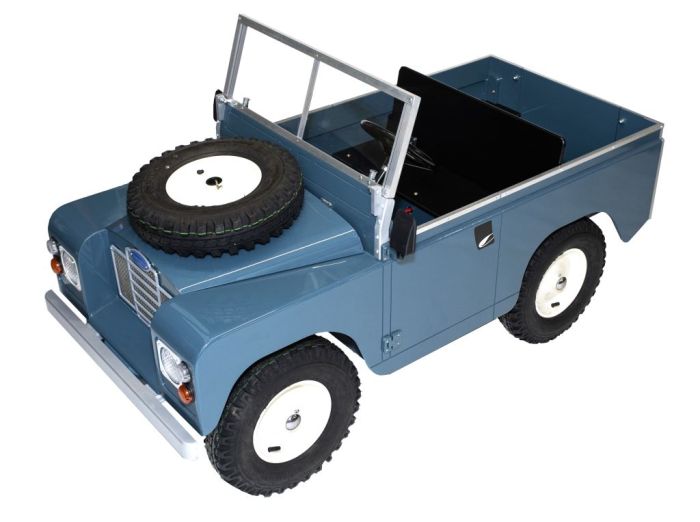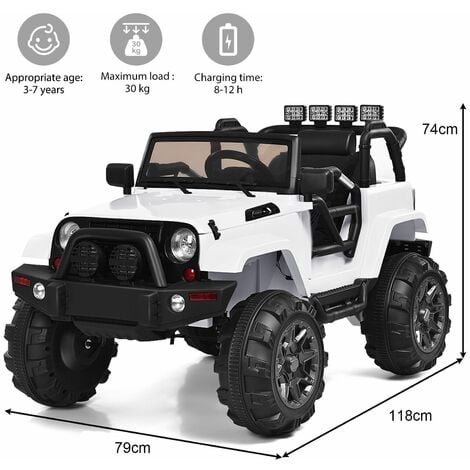Knowing the charging duration and battery life of the electric ride on your kids cars will allow you ensure that your kids are entertained for a long time. This is all you need to be aware of about the battery type.
Most electric ride on cars for kids run on rechargeable batteries. They are either lead-acid or Lithium-ion. Lithium-ion batteries generally offer longer battery life as well as faster charging times compared to lead-acid batteries.
Capacity of Battery
The battery capacity, measured in ampere-hours (Ah) or Watt-hours (Wh), determines how long the ride-on car will run on a single charge. The capacity of the battery is crucial because it determines how long the ride-on vehicle can run before recharging.
Run Time -
The run time is the longest duration of continuous operation an electric ride on car can achieve with one charge. This can be affected by factors such as the battery's capacity, the power of the motor, the terrain or the weight of a driver.
Common run times for electric ride-on vehicles range between 30 minutes and 2 hours with one charge. Some high-capacity battery packs may provide longer durations.
Charging Time
The charging time refers how it takes to charge a completely exhausted battery. Charge times differ depending on the battery's capacity, charger specifications, and the charging method.
Charge times range between 8 and 12 hours to full charge for electric rides-on automobiles. Certain models, specifically ones with lithium-ion battery technology, may have faster charging times.
Battery safety and longevity depend on the charging of the battery in accordance with the specifications of the manufacturer. Battery performance can be adversely affected when the battery is charged too high or is undercharged.
Charge Method -
Most electric vehicles include a charging cable that plugs directly into a household outlet. Certain models provide rapid charging or come with a clever charger that regulates the speed at which the battery is charged.
Ensure that the charger port and connectors are compatible with the charger supplied by the ride-on vehicle in order to protect the battery or electrical system.
Batteries for Additional Use
Certain electric rides on cars offer the possibility to purchase additional batteries or spare batteries to play for longer periods of time. If you have extra batteries on-hand, you can quickly swap them out for fully charged ones to minimize the time between repairs.
Understanding the battery and charging time of a kid's vehicle will ensure that your child and you enjoy uninterrupted, fun time as well as thrilling adventures. Continuously charging the battery and observing appropriate charging guidelines will to extend the life of your battery and improve its performance. Take a look at the most popular remote control childrens cars for website examples including ride on car, toy with car, childs car toy, electric toy car, ride of car, electric ride on cars, childrens electric cars, car on ride, childrens digger, electric ride along car and more. .

How Do You Keep And Put Together A Kid's Ride-On Vehicle?
It is typical for children's' ride-on car to require some assembly along with ongoing maintenance, in order to ensure optimal performance and security. Here are a few common maintenance and assembly requirements for kids' ride-on vehicles:
Most ride on cars are partially assembled at the time of arrival and require some assembly. It usually involves attaching parts such as the wheels as well as the seats, steering wheel and other components according to the manufacturer's instructions.
Assemble the parts according to the instructions. Use the provided equipment and tools according to the instructions for completing the assembly.
Cleaning -
The cars that ride on them must be cleaned regularly to ensure they look good and perform correctly. Use a soft, damp cloth using mild soap and water to clean the exterior surfaces.
Particular attention must be paid to the areas that are susceptible to accumulation, such as wheels, tires and undercarriage. Brush or use a tooth brush to scrub areas that are hard to reach, and also remove stubborn dirt.
Avoid using harsh chemicals, abrasive cleaners or high-pressure water spritzers, since they could damage the electronic or paint components of the ride-on car.
Battery Care
The battery of the car that rides on it must be properly cared for to ensure that it performs well and lasts as long as is possible. Follow these guidelines to take care of your battery -
It is essential to charge your battery fully prior to and after every use to get the most out of it.
Avoid overcharging batteries or leaving them connected to chargers for extended durations. This could damage batteries and decrease their lifespan.
If not in use when not in use, store the ride on battery and car away from direct sunlight or extreme temperatures.
Examine the battery terminals regularly for damage or corrosion. Clean them as needed by using the help of a wirebrush or a terminal cleaner.
Replace the battery in case it does not hold any charge or displays signs that it has been damaged or degraded.
Tire Maintenance -
Inspect the tires frequently to find any indications like wear, damage or the loss of pressure. When needed, use a bicycle air pump or air compressor to inflate tires to the appropriate pressure.
Inspect the tread pattern for debris or other foreign objects that may cause flats or punctures. Replace or repair damaged tires if required. Clear obstructions.
Lubricate axles and wheel bearings regularly to minimize friction and ensure smooth rotation.
Sometimes, repairs or replacements are needed
Wear and tear, or even accidental damage could cause ride-on car parts to require replacement or repair.
Check for indications of a malfunction or degrade for example, a weird sound and erratic behavior or power loss. For help with troubleshooting or repairs, consult the manufacturer's instructions.
To prevent further damage, replace damaged or worn parts as soon as is possible to ensure the safety of your equipment and its functionality.
Follow these instructions to maintain your child's ride-on vehicle and to provide hours of enjoyment and safe play time for them. Take a look at the recommended read more on ride on toys for website info including car electric ride on, toy the car, a toy car, toy and car, electric rideons, a toy car, car for toy, 2 seater electric cars, toy ride, two seater childrens electric cars and more. .

What Factors Should I Take Into Consideration Prior To Buying An Electric Vehicle For My Child? Pros And Pros?
There are many factors to consider when choosing an electric kids car. Take note of these important aspects, which include information about prices, sizes, pros, cons, and more.
Pick an electric car for your child according to the size and age of your child. Younger children and those with smaller sized bodies might prefer smaller and lighter models, while older or larger children may require larger vehicles with enough space to fit them comfortably.
Car size and weight -
Electric cars for children come in various dimensions. They range from tiny replicas to larger-scale replicas. Consider the size and weight of the car in relation with your child's strength, age, and size.
Price Range
The cost of electric vehicles for children can be a bit different according to a myriad of factors including the size, model and the quality. The prices of small-sized models typically vary between $50 and 200 dollars, whereas the costs for larger scale models can vary from $200 up to $800.
The pros and cons of -
Pros -
Electric kids' car offer hours of entertainment and imagination for your children. It allows them to feel the thrill driving their very own vehicle.
Motor Skill Development. Operating an electric car helps children to develop coordination abilities spatial awareness as well as fine motor skills.
Electric cars are ideal for outdoor activities. They encourage exercise, exploration and physical exercise.
Realistic Features - A lot of electric kids' cars feature real-life features, such as working headlights, horn sounds, as well as MP3 player compatibility, enhancing the experience of playing.
Cons
Cost - The best electric children cars aren't cheap particularly licensed replicas of well-known car brands.
Battery Life: Electric cars run on rechargeable lithium-ion battery that have a life-span that is limited and must be recharged regularly.
Safety Concerns - Electric cars could pose safety hazards, including collisions, falls, and entrapment, if not handled with caution and under adult supervision.
Maintenance and Assembly: Some electric vehicles require assembly before they arrive and need regular maintenance, including repairs and maintenance of the battery.
Features and Accessories
Check out the features and accessories that you can get for your electric car for kids. For instance, you can have working headlights and the sound of a horn. Select a car that is compatible with your child's preferences and interests.
The best electric kid's car will depend, in end, on your child's age and their size, as well as their interest as well as your budget. Before you make a choice make sure you look over and compare different models. Review reviews and weigh the pros and cons. Check out the recommended remote control childrens cars kidscars.co.uk advice for site tips including childrens digger, toy and car, ride on car, car toy toy, toy car for car, race car toy car, childrens electric ride on, kids electric cars, car electric ride on, ride a toy and more. .
